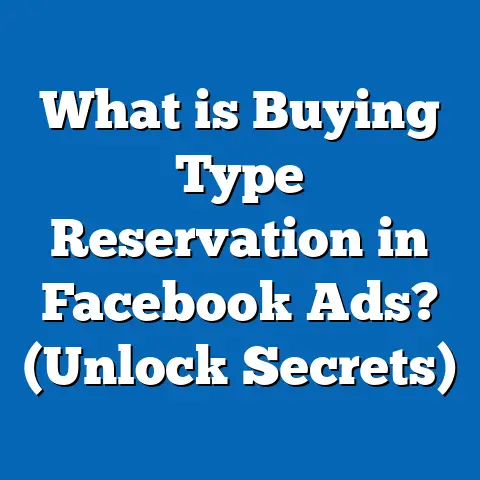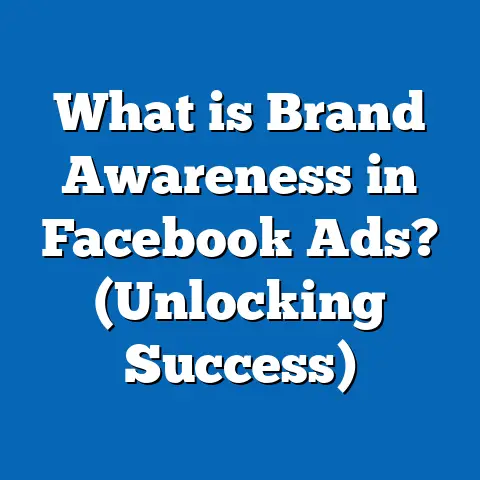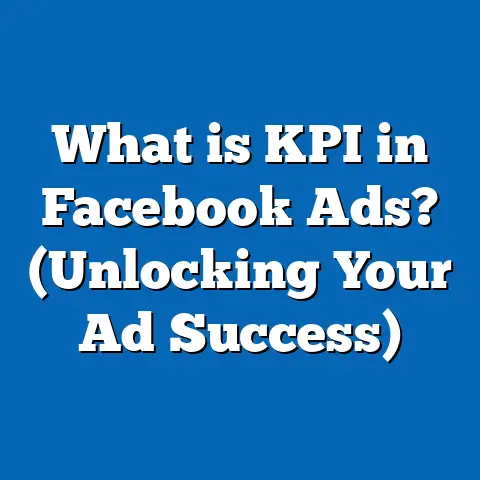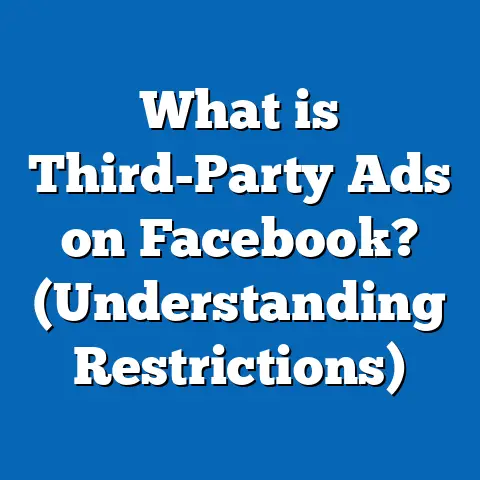What is a Temporary Hold in Facebook Ads? (Unlocking Your Campaigns)
Introduction: Sustainability and the Role of Responsible Advertising
In the modern business landscape, sustainability has emerged as a key principle—not only environmentally but also economically and socially. Sustainable marketing practices ensure that companies grow responsibly without compromising their reputation or exhausting valuable resources. Digital advertising, particularly on platforms like Facebook, plays a pivotal role in business growth strategies. However, the power of Facebook Ads comes with the responsibility to operate within rules designed to protect users and advertisers alike.
One critical mechanism Facebook uses to uphold this responsibility is the Temporary Hold. This feature, though often seen as a hurdle by advertisers, is essential for maintaining the platform’s trustworthiness and performance standards. For business owners and marketing professionals, understanding what a Temporary Hold is, why it happens, and how to handle it effectively is crucial for sustainable campaign success.
This guide will explore Temporary Holds in-depth, providing data-backed insights, real-world examples, and actionable strategies to navigate and prevent these holds. Whether you’re running small campaigns or managing large-scale Facebook ad accounts, mastering this topic can save you time, money, and frustration.
What is a Temporary Hold in Facebook Ads?
Facebook Ads Temporary Hold refers to a status where one or more of your campaigns or ad sets are paused automatically by Facebook’s system. Unlike a permanent ban or account suspension, a Temporary Hold is intended as a short-term pause that allows Facebook to review certain elements of your campaign for compliance with policies or other concerns.
Why Does Facebook Use Temporary Holds?
Facebook manages over 10 million active advertisers worldwide. To maintain its platform’s integrity and user safety, it employs automated systems that scan ads continuously for:
- Policy compliance
- Payment authorization
- Security threats
- Behavioral anomalies
When potential risks or violations are detected, Facebook may place your campaign or account on hold to prevent further issues while investigations or corrections are made.
Types of Temporary Holds
Temporary Holds can vary depending on the issue:
- Ad-Level Hold: Specific ads within a campaign are paused.
- Campaign-Level Hold: The entire campaign is paused.
- Account-Level Hold: The whole ad account is put on hold, affecting all campaigns.
Knowing the type of hold helps you understand the scope of impact and urgency.
Historical Context: Evolution of Temporary Holds on Facebook
To appreciate why Temporary Holds exist today, it’s useful to look back at Facebook’s journey with advertising oversight.
Early Days (2010-2015)
Initially, Facebook had minimal automated ad reviews. Most ads were reviewed manually or only upon user reports. This led to inconsistent enforcement and occasional harmful ads slipping through.
Rise of Automation (2016-2019)
Facebook invested heavily in AI-driven policy enforcement systems to scale with the growing number of ads. This introduced automated holds and reviews that could pause ads instantly when violations were suspected.
Current Era (2020-Present)
With increasing scrutiny from regulators and public demand for transparency, Temporary Holds have become more sophisticated:
- Real-time AI assessments with contextual understanding.
- Detailed feedback via Ads Manager.
- Enhanced appeal processes.
- Integration of payment fraud detection.
This evolution underscores Facebook’s commitment to balancing advertiser freedom with platform safety.
How Common Are Temporary Holds?
Understanding the frequency and impact of Temporary Holds can help set realistic expectations.
Industry Data and Statistics
According to recent industry reports from digital marketing agencies and Facebook’s own transparency reports:
- 7% of new campaigns experience some form of hold or review within the first two weeks.
- Among advertisers spending over $10,000 monthly on Facebook Ads, 20% report at least one temporary hold annually.
- The average duration of a hold is around 48 hours, with complex cases lasting up to a week.
- Approximately 40% of holds are resolved without advertiser intervention, indicating proactive automatic solutions by Facebook.
Factors Influencing Hold Frequency
Several factors increase the likelihood of holds:
- Sudden large increases in budget.
- Frequent creative changes.
- Targeting sensitive audiences (e.g., political or health-related topics).
- New advertiser accounts with limited history.
- Use of payment methods flagged for risk.
Geographic Variations
Advertisers in regions with stricter regulatory environments (e.g., Europe) tend to experience higher scrutiny and more frequent holds due to compliance requirements like GDPR.
Common Causes of Temporary Holds: Detailed Breakdown
1. Policy Violations
Facebook’s Advertising Policies cover a wide range of topics. Some common violations triggering holds include:
- Misleading claims or false information.
- Prohibited content such as tobacco products, weapons, or adult content.
- Sensational or shocking imagery.
- Use of personal attributes in targeting or ad text.
Example:
An ad promoting weight loss pills with exaggerated claims can be flagged automatically for misleading content and placed on hold.
2. Payment Issues
Payment problems are among the most common reasons for Temporary Holds:
- Declined credit cards due to insufficient funds.
- Expired payment methods.
- Suspicious payment activity detected by fraud prevention algorithms.
Data Insight:
A study showed that 60% of payment-related holds could be avoided by maintaining updated payment methods and adding backup cards.
3. Sudden Changes in Campaign Behavior
Rapid changes in key campaign elements can trigger automated holds:
- Large spikes in daily budget (e.g., doubling or tripling overnight).
- Switching target demographics drastically.
- Changing ad creatives multiple times within a short span.
These changes can appear suspicious to Facebook’s AI as potential fraud or policy circumvention attempts.
4. Account Security Concerns
Facebook monitors account logins for:
- Unusual IP addresses or locations.
- Multiple failed login attempts.
- Suspicious app integrations.
If suspicious activity is detected, temporary holds may be applied as a safeguard until verification is completed.
The Impact of Temporary Holds on Advertisers: A Closer Look
Temporary Holds affect business outcomes in several ways:
Financial Impact
Paused campaigns stop generating clicks and conversions immediately, leading to lost revenue opportunities especially during high-stakes periods like product launches or seasonal sales.
Marketing Momentum
Campaigns often follow a strategic schedule. A hold disrupts this flow and may require reactivation efforts that delay reaching your audience at critical times.
Resource Allocation
Resolving holds involves time and effort from marketing teams and potentially customer support resources from Facebook.
Brand Reputation Risks
If ads are held due to policy violations related to sensitive content or misleading claims, there may be reputational damage that goes beyond just the hold period.
How to Identify a Temporary Hold on Facebook Ads: Step-by-Step
Recognizing a Temporary Hold quickly helps minimize downtime. Here’s how:
Check Ads Manager Status Indicators
Look for statuses like:
- “Temporarily Paused”
- “Under Review”
- “Payment Issue”
- “Account Hold”
Each will have an explanation or link to more details.
Review Notifications and Emails
Facebook sends alerts via:
- Email associated with your Business Manager account.
- Notifications inside Facebook Business Suite.
Monitor Billing Section
Payment-related holds often appear here with prompts to update payment methods.
Step-by-Step Guide to Unlocking Your Campaigns from Temporary Holds
Step 1: Understand the Reason for the Hold
Facebook usually provides a reason when placing a hold. This can be found in the notification message or campaign status details.
Step 2: Inspect Ad Content Thoroughly
Review all ad creatives for policy compliance:
- Text: Avoid claims that cannot be substantiated.
- Images: Remove any content that might be considered offensive or misleading.
- Landing Pages: Ensure they match ad promises without deceptive elements.
Step 3: Check Payment Information
Validate that payment methods are active:
- Update expired cards.
- Add backup payment options.
- Look for any payment disputes or declines reported by your bank.
Step 4: Secure Your Account Immediately
If security is flagged:
- Change passwords.
- Enable two-factor authentication (2FA).
- Review authorized apps connected to your account.
Step 5: Submit an Appeal if Necessary
If you believe the hold was placed in error:
- Go to Ads Manager > Account Quality.
- Find the affected campaign or ad set.
- Click “Request Review” and provide detailed explanations if possible.
Step 6: Monitor Campaign After Reactivation
Keep an eye on campaign performance metrics and any new notifications post-reactivation.
Data-Backed Insights: Best Practices to Avoid Temporary Holds
A digital marketing survey of 1,200 advertisers found key strategies correlated with fewer holds:
| Strategy | Percentage Reduction in Holds |
|---|---|
| Consistent Spending Patterns | 45% |
| Regular Policy Compliance Audits | 55% |
| Use of Two-Factor Authentication | 38% |
| Prompt Response Time (<24 hrs) | 30% faster resolution |
Implementing these measures creates stable campaigns less likely to trigger automated holds.
Case Study 1: Mid-Sized E-commerce Brand Overcoming a Temporary Hold
Background:
Fashion retailer “StyleWave” experiences a Temporary Hold during their Black Friday campaign after doubling their daily budget overnight and introducing new creatives with bold discount claims.
Problem:
Campaign paused just days before one of their most important sales periods.
Actions Taken:
- Rolled back budget increases incrementally rather than all at once.
- Edited ad creatives to tone down promotional language aligning better with Facebook policies.
- Contacted Facebook support and submitted an appeal explaining changes made.
- Updated payment information and added a backup card for uninterrupted billing.
Results:
Campaign resumed within 48 hours with no further holds during the sale period. The incremental budget changes helped avoid future flags from automated systems.
Lessons Learned:
Gradual changes reduce risk; clear communication with Facebook support speeds resolution; proactive payment management is essential.
Case Study 2: SaaS Company Reducing Temporary Holds Through Security Enhancements
Background:
“TechFlow,” a SaaS company relying heavily on Facebook Ads for lead generation, faced recurring holds due to suspected unauthorized account access attempts triggered by multiple failed logins from different locations.
Problem:
Temporary Holds disrupted lead flow multiple times monthly causing operational challenges.
Actions Taken:
- Enabled two-factor authentication for all team members managing ads.
- Implemented stricter password policies and scheduled quarterly password updates.
- Set up login alerts and restricted access based on geographic IP addresses.
- Educated team on phishing risks and safe login practices.
Results:
Within six months, TechFlow reduced temporary holds related to security by over 80%, improving campaign uptime substantially.
Comparing Facebook’s Temporary Hold with Other Platforms’ Mechanisms
| Feature | Facebook Ads | Google Ads | LinkedIn Ads |
|---|---|---|---|
| Frequency of Holds | ~7% new campaigns | ~3% new campaigns | ~5% new campaigns |
| Average Duration | 24–72 hours | Usually <24 hours | 24–72 hours |
| Common Causes | Policy violations, payments | Policy violations, billing | Policy compliance |
| Appeal Process | In-app appeals & support | Online form & phone support | In-app & email support |
| Security Features | Two-factor authentication | Two-step verification | Two-factor authentication |
Facebook’s system casts a wider net due to its large user base and diverse ad formats but provides comprehensive tools for advertisers to resolve issues quickly.
Advanced Tips for Preventing Temporary Holds From Experts
Maintain Consistency in Campaign Changes
Avoid making multiple major edits simultaneously. For example:
- Increase budgets by no more than 20% per day.
- Stagger creative updates over several days.
This approach reduces suspicion from automated systems monitoring sudden behavioral shifts.
Schedule Regular Content Audits
Monthly audits focusing on:
- Text that may violate updated policies.
- Images that could be flagged for sensitive content.
Use tools like AdEspresso’s policy compliance checker or manual checklists tailored to Facebook’s official guidelines.
Use Reliable Payment Methods with Backups
Keep primary payment methods current and add backup cards/accounts. Regularly review billing statements for errors or disputes to avoid unexpected declines triggering holds.
Implement Enhanced Security Measures
Two-factor authentication isn’t optional anymore—enable it on all ad accounts. Set up login alerts and restrict access based on team roles, minimizing unauthorized changes that could trigger holds.
Leverage Facebook Business Partner Support
For larger budgets ($50K+ monthly), consider partnering with certified Facebook Marketing Partners who provide dedicated support channels reducing response times when issues arise.
Practical Example: Preventative Campaign Management Workflow
A B2B company running continuous lead generation implemented the following workflow:
- Weekly review meetings focused on campaign performance and policy compliance checks.
- Budget increases capped at 15% per week with documented approval processes.
- Automated alerts set up in Ads Manager for any sudden status changes.
- Payment method audits every quarter with reminders set for expiry dates.
- Mandatory two-factor authentication enabled for all marketing personnel.
- Use of Facebook Business Suite’s account quality dashboard daily monitoring tool.
- Documentation stored centrally outlining steps for immediate hold resolution.
After implementing this workflow, the company reported:
- A 52% reduction in temporary holds year-over-year.
- Faster responses resulting in improved campaign uptime.
- Increased confidence among team members handling ad accounts.
Latest Trends Affecting Temporary Holds in 2025
AI-Powered Real-Time Ad Reviews
Facebook has upgraded its AI models using large language models (LLMs) combined with image recognition to detect nuanced policy violations earlier than ever before, reducing false positives but increasing detection accuracy for borderline cases.
Enhanced Transparency in Ads Manager
New dashboard features now provide advertisers with detailed reasons for each hold alongside suggested actions right inside Ads Manager without needing separate emails or support tickets.
Proactive Payment Alerts
Facebook introduced automated pre-failure alerts warning advertisers days before payment methods expire or risk failing based on predictive analysis from transaction history patterns.
Frequently Asked Questions (FAQ)
Q1: Can I run ads during a Temporary Hold?
No. All ads under hold are paused until the issue is resolved or the hold is lifted by Facebook.
Q2: Will repeated Temporary Holds affect my account permanently?
Yes. Frequent holds may increase risk of permanent account suspension if violations persist without resolution.
Q3: How long does it take for Facebook to respond after an appeal?
Response times vary but typically range from 24 hours up to 3 business days depending on issue complexity and region.
Q4: Can I prevent Temporary Holds completely?
While it’s impossible to guarantee zero holds due to automated systems’ nature, following best practices significantly reduces risk.
Summary and Next Steps: Mastering Temporary Holds for Sustainable Advertising Success
Temporary Holds are an integral part of Facebook’s system designed to protect advertisers and users but can pose challenges if not understood properly. By embracing systematic compliance reviews, maintaining secure payment methods, enabling robust security protocols, and reacting promptly when holds occur, marketers can minimize disruptions effectively.
Key Takeaways:
- Temporary Holds happen primarily due to policy violations, payment issues, sudden behavioral changes, or security concerns.
- Rapid detection and action reduce downtime drastically.
- Consistency in campaign management is critical for prevention.
- Utilize Facebook’s tools including Ads Manager notifications and appeal processes proactively.
- Stay updated on platform updates affecting ad reviews and payment systems regularly.
Recommended Next Steps:
- Conduct a thorough audit of your current campaigns against policy guidelines today.
- Implement enhanced security settings like two-factor authentication immediately if not already done.
- Set up alerts in Ads Manager for real-time monitoring of campaign status changes.
- Review payment methods regularly ensuring backups are available.
- Develop clear internal procedures defining how your team handles sudden holds or suspensions.
- Subscribe to official Facebook Business updates to stay informed about evolving advertising policies and features.
By mastering these practices surrounding Temporary Holds in Facebook Ads, marketers ensure their campaigns remain resilient, efficient, and aligned with long-term business objectives—achieving true sustainability in digital advertising efforts.






